Last Updated: February 14th, 2020
We were early adopters of the Profoto A1 flash at the start of 2018. The first time we saw some marketing videos on it, it grabbed our attention and hooked us more than pretty much any other product before it. For years we have used other flash units by Yongnuo and Canon, but as time went on and our requirements as photographers became more significant, we needed a flash product that would be easier to use and more reliable.
When pulling the trigger on this expensive piece of camera gear, we had at the front of our minds – will this thing be worth it?
The Profoto A1 is an excellent flash for a variety of use cases. After more than a year of use, we can say this definitively. We were so impressed that we ended up buying a second unit to have along with us for the ride.
In this time, we’ve had the opportunity to use the A1 in many different shooting situations and environments. We’ve seen its performance first hand. And yes, unlike the earliest reviews to come out around release, we have also had time recognize the flaws.
It’s from this perspective that we are able to give you a detailed review of the Profoto A1 – a flash we love, and maybe you will too!
The Profoto A1 vs. Any Other Flash On the Market
Before we get into the real meat of our Profoto A1 review, we wanted to start off by addressing the elephant in the room: the cost.
Our thoughts upon finding out how much it was: “Holy ****”
Let’s get it out of the way: this is not your average photography gear purchase.
It’s not created for beginner photographers – though this is unfortunate given how it is far more intuitive and simple to use than most flashes on the market.
The A1 is really for professional photographers who can afford it, and hobbyists with a good deal of money to spend on more luxury equipment. In our case, we honestly hate spending money when we don’t need to but will do it if there is enough value being provided.
Because we have our own wedding photography business, we were able to purchase the Profoto A1 units (along with everything else we own) on our business credit card and deduct these purchases as expenses on our taxes. It is because of this that the cost was less a factor for us, so it’s something to consider.
At its core, one thing is very clear:
Profoto is asking for a lot from its customers and prospective customers – as they do with all of their equipment.
There are, without a doubt, more affordable options on the market if you are on a budget. We actually highlight some of these on our Recommended Flash Gear page. We could literally pack our car with 70$ Yongnuo speedlites (read: 14 of these flashes) as opposed to buying the Profoto A1. Even despite this, our preference is to spend more money on 1 good flash that won’t be a hassle and will perform quickly and well with no questions asked.
In summary – the Profoto A1 is expensive and not for everyone. It is, however, worth the price if you can afford it. It has worked much better for us when compared with other products we have used ranging from 1/10th the price to half of it.
Decision time:
- If the cost is a deterrent for you, then we recommend against purchasing this product.
- If the idea of spending this kind of money on a flash is something that could be okay if it actually works well, then the rest of this review is for you!
Why We Bought the Profoto A1 Flash
We are not photography newbies. We’ve been creating photography for several decades thanks to our combined experience. From our earliest years in middle school taking photos for fun to our professional careers as wedding and portrait photographers today, you could say we’ve been around the block a few times.
This is something we point out to showcase that our experiences are significant, and we’re not easily swayed to jump on to every new piece of camera equipment that comes along.
For the longest time, flash photography was not something we cared for all that much. In truth, it was never all that necessary when photographing as a hobby – because we could be a lot more selective of the locations and subjects we were capturing. At the time, our preference was strongly towards landscapes and other outdoorsy things.
As we started to get into portrait photography and, soon after, wedding photography, things started to change. We consider it to be an impossible task to photograph an entire wedding without flash. Just step into the average dark reception hall and this becomes crystal clear.
This is where we started to really spend some money on flash gear.
In the early stages, we needed something cheap but workable, and that’s exactly where those Yongnuo speedlites we mentioned earlier came in. For their price point, they are really exceptional pieces of equipment – but they were confusing to use, ate up batteries like no tomorrow, would overheat, and at times would even be really unreliable. In some ways we could adapt to the gear – such as through buying better rechargeable speedlite batteries. In other ways, it was apparent we were starting to outgrow our equipment.
These drawbacks paired with having to comb through hours of resources online to figure out how to effectively use those older flashes were significant. We wanted something that was easier to use on the fly – as is needed during a wedding day. Being able to save a minute here and there is a game changer. That’s when the Profoto A1 came on our radar.
Our jaws dropped when we saw the first video for the A1 flash.
The ease of use looked to be right off the charts. We waited diligently for it to come out so we could see at least a couple reviews. We were quickly convinced, and bought one for ourselves.
Our Purchase Receipt for PROOF:

We order our photo equipment regularly through Amazon. The Profoto A1 is available for Canon and Nikon.
What Is the Profoto A1, Really?
The Profoto A1 is a flash unit intended for studio and field work. It functions much like a traditional speedlite in that it slips into your camera’s hotshoe. You can also pair a second Profoto A1 (or any other Profoto flash) with this to use as an off camera flash – we have done this ourselves with both our 2nd A1 as well as our Profoto B1X monolight.
The three ways the A1 really differentiates itself from almost every other flash available on the market are these:
- It has a built in receiver/transceiver system utilizing the Profoto AirRemote TTL functionality (this means: you no longer need to use a transmitter system again).
- It uses a proprietary battery. The A1 has a single battery, while most other flashes rely on multiple AA batteries for use.
- It has a simplified user interface (UI). It took us about 10 minutes to figure out exactly how to use the Profoto A1, while previous flashes required much more extensive research and practice to master.
What You Get When You Buy the Profoto A1 Flash
The Profoto A1 flash includes: the flash unit, a carrying case, a diffuser attachment, a battery, and a battery charger – all packaged in a sleek box.
Included here are Profoto A1 product photos to give you a better sense of the product:
The box:
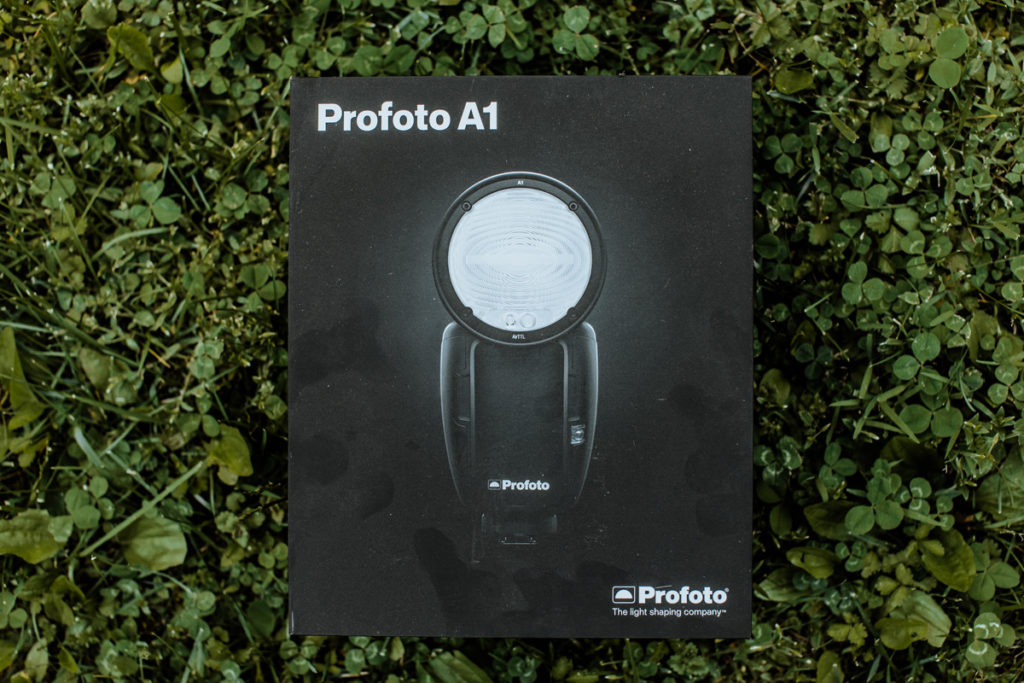
While the packaging literally does not matter in the scheme of things, we were weirdly impressed by it – with it’s velvety texture giving us a sense that we just bought something legit.
Note: we didn’t notice the dust before taking this picture. The dust is (obviously) indicative that we’ve had the box for a long time stuffed away in some weird corner of our office.
The carrying case:
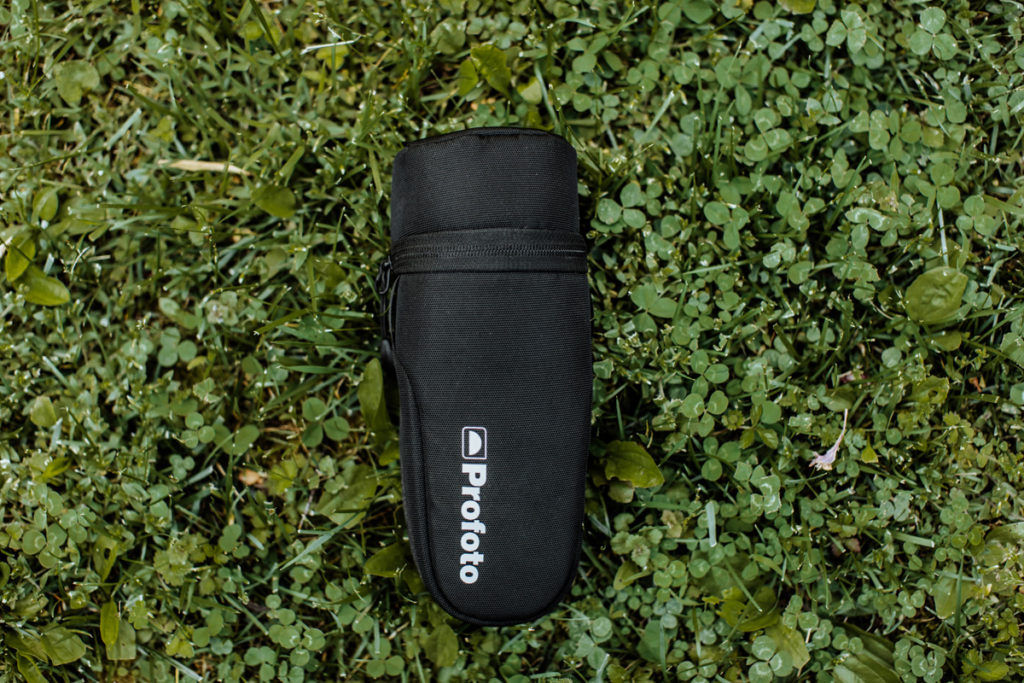
The carrying case is standard for what you would expect from a flash case.
The Profoto A1:
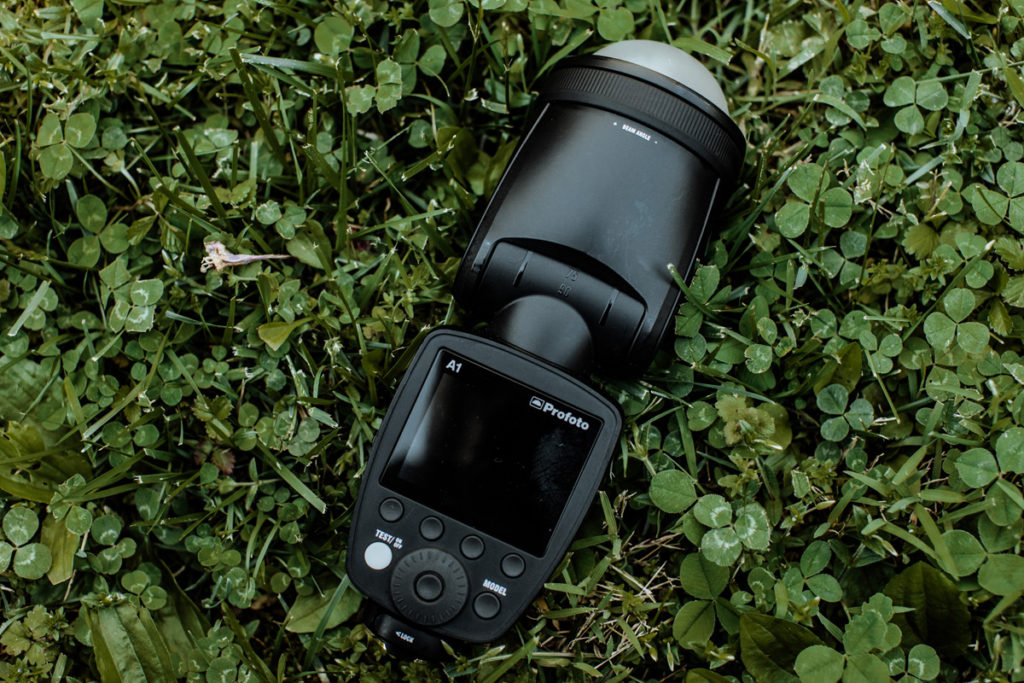
This is the main view you will have of the A1 while you use it. It is lightweight and has a great design.
Using the white button in the left corner, you can turn on the flash, turn off the flash, and fire a test flash. In addition, the swivel head is an excellent addition – allowing us to adjust the direction of our lighting. This is great when shooting indoors as we often will prefer to bounce our flash off the ceiling or walls around us.
The Profoto A1 turned on:
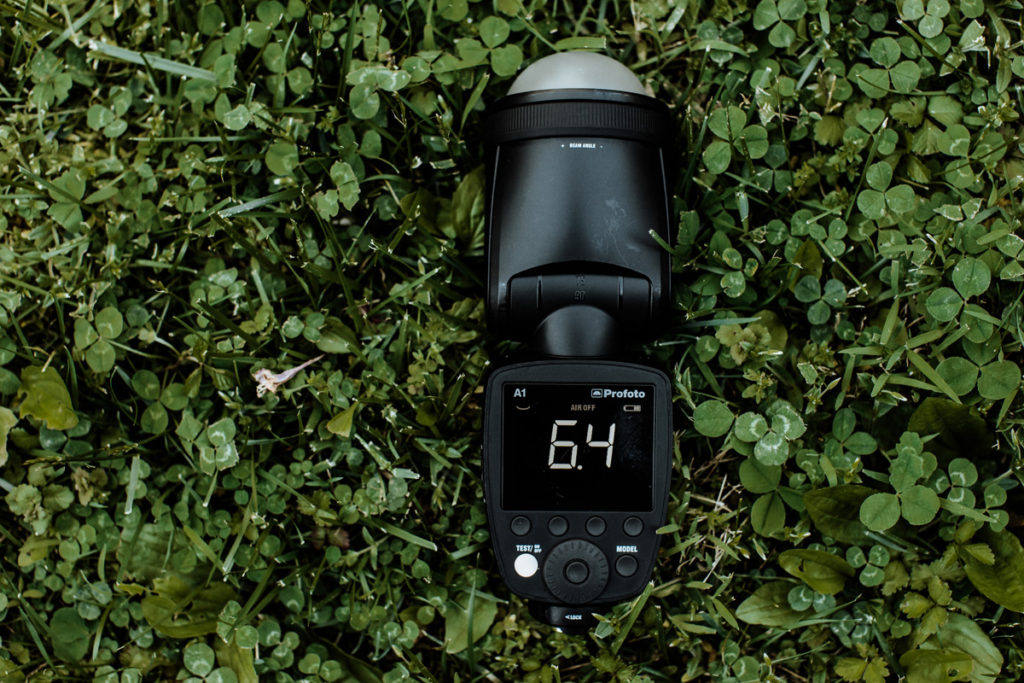
The initial screen you will encounter reveals the flash power setting. This can be easily adjusted manually by using the rotating black dial in the center of the device.
Manual & TTL (Auto) Flash Modes:

The Profoto A1 can be used in both manual and TTL modes. Unlike other flashes we have used that (for some ungodly reason) make even a simple adjustment like this a challenge, the A1 has a simple switch on the side. Your choice of Manual or TTL mode will reflect on the screen.
The Profoto A1 (Back Side):
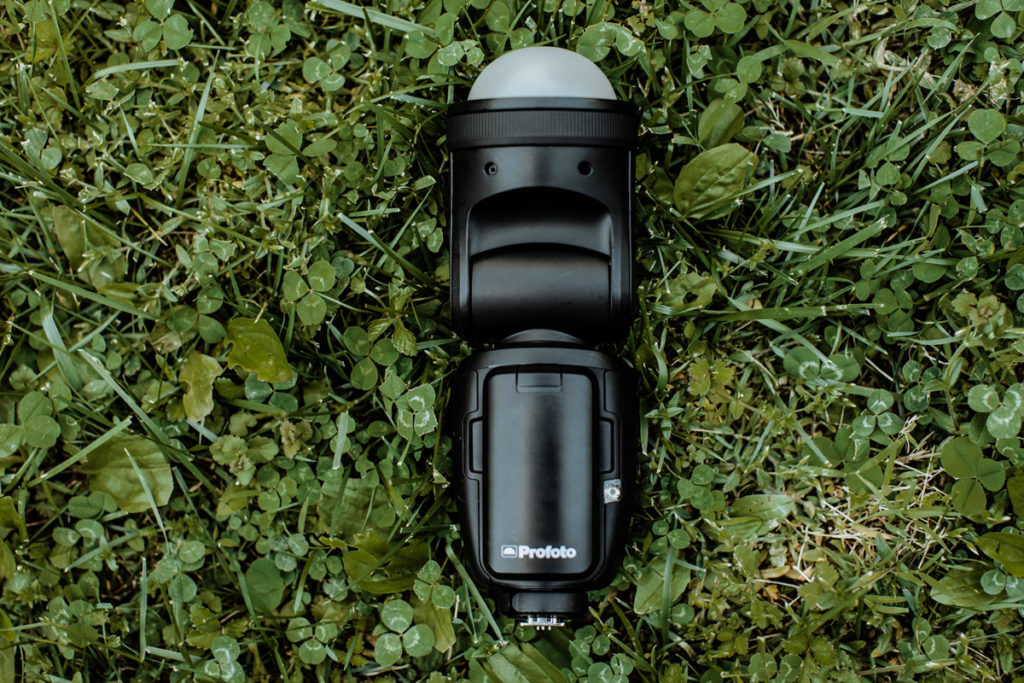
The A1’s battery sits firmly in the back. This is very different compared to most on camera flashes, which normally have a built in battery port on the side.
Profoto A1 (with battery removed):

This is a simple image comparing the size of the A1 with it’s battery.
Profoto A1 flash & battery charger:
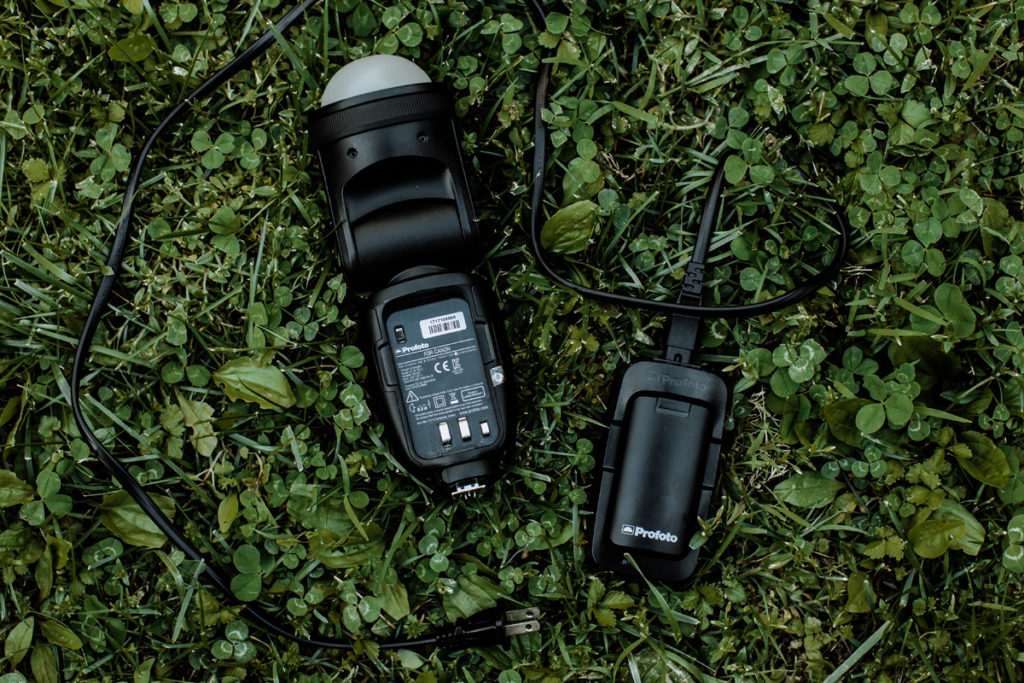
The battery charger does exactly what you would expect it to do. 🙂
Profoto A1 Flash vs. Yongnuo YN600EX-RT II Speedlite:
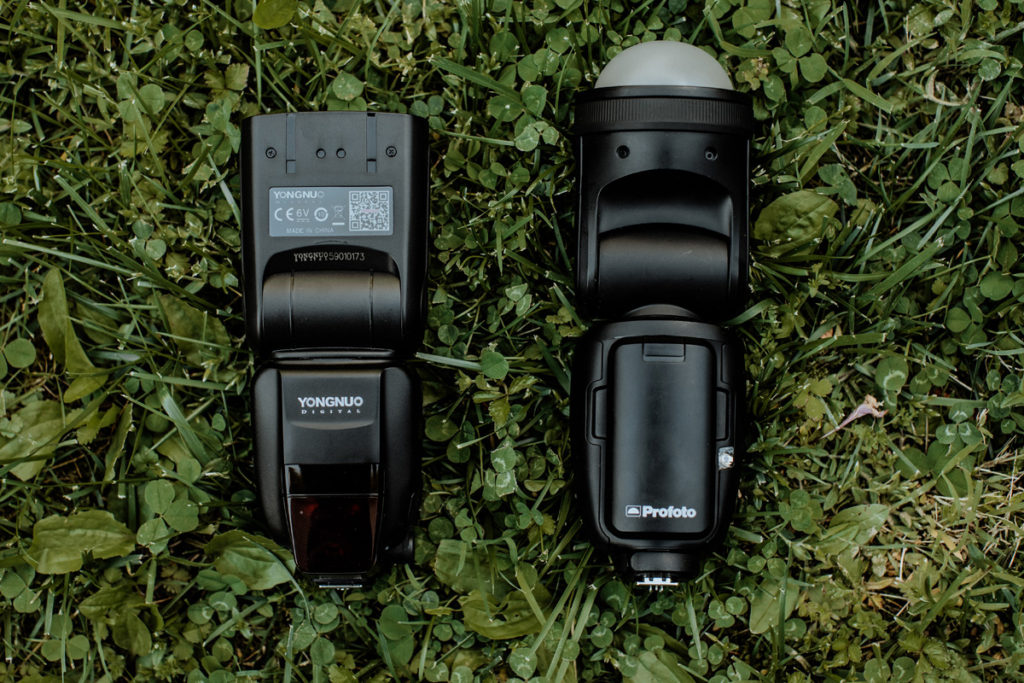
For fun, we grabbed a shot comparing the Profoto A1 flash with the Yongnuo YN600EX-RT II speedlite. We still hold on to our Yongnuo gear, however we rarely have a need for it these days. This Yongnuo flash model is great for beginners (and is priced accordingly). For more taxing use, it was just not able to perform for our needs of a consistently reliable flash for 8, 10, 12 or longer hour days of shooting.
Profoto A1 Flash vs. Canon 600EXII-RT Speedlite:
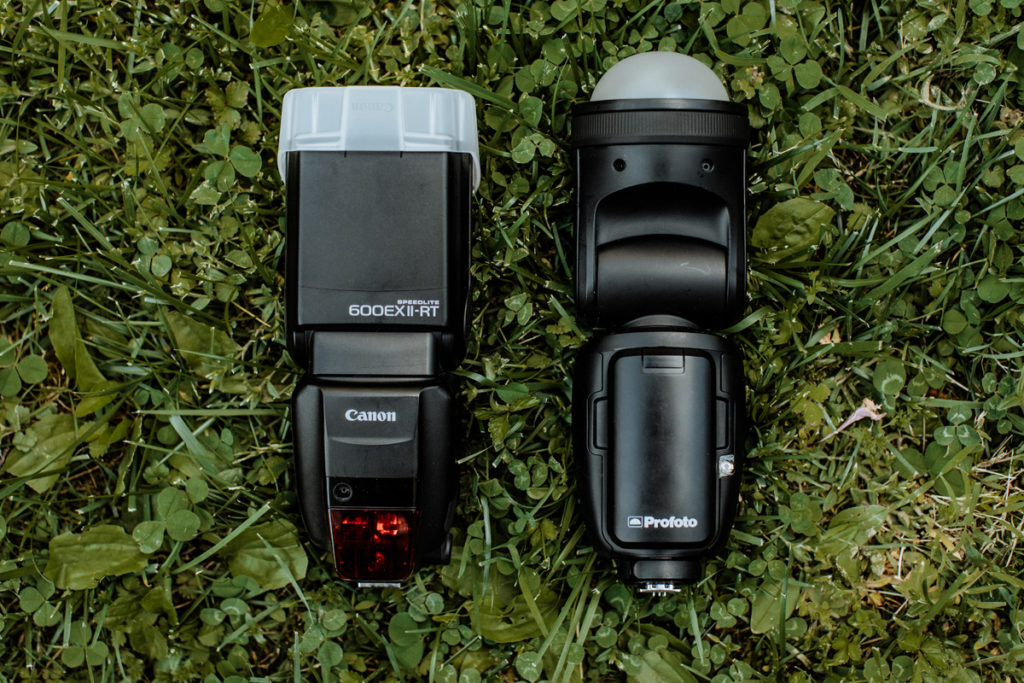
Another comparison shot, this time showing off the differences and similarities of the Profoto A1 flash with the Canon 600EXII-RT speedlite. The Canon is actually an excellent flash – with the biggest issue being it’s UI. These days, we’re looking at a 200$ – 300$ price difference – and for that we consider the streamlining efforts and comparable simplicity of the A1 to allow it to shine through in our book.
How to Use the Profoto A1 Flash
We want to make our Profoto A1 flash review actually useful for you. We hope up to this point you are already getting some insights that may have been lacking in other reviews online.
The one thing in particular we wanted to show off is how the A1 actually works. To do this, we’re going to walk you through the menu system and explain what each thing does. From there, we’ll get into a more practical conversation of how to use the flash to capture great images.
Profoto A1 Flash – Menu System
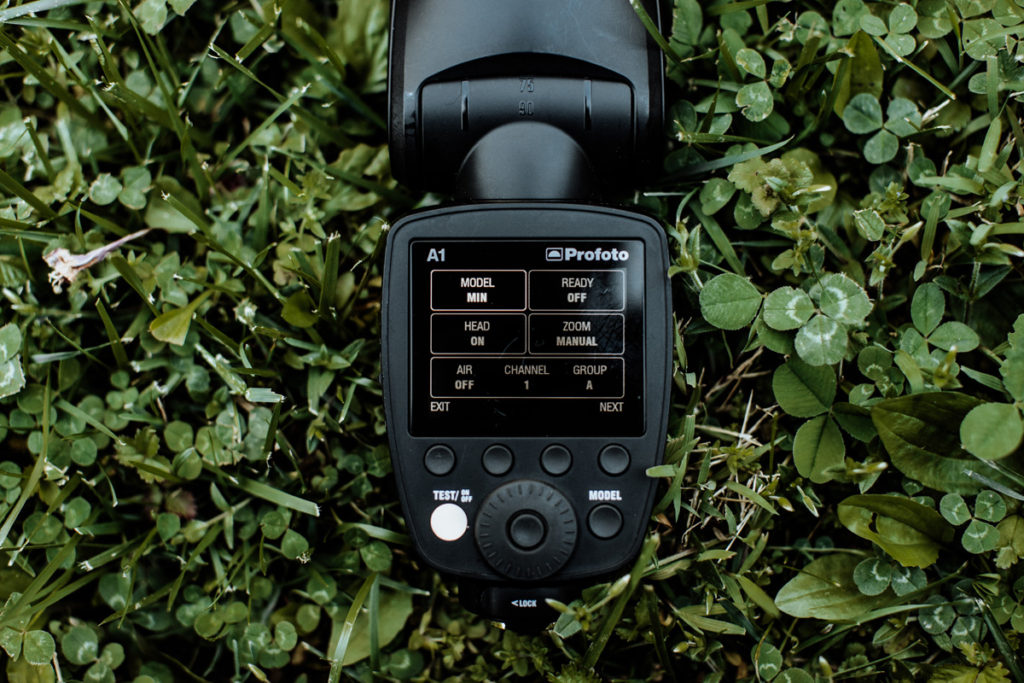
After pressing the black button in the center, you will open up the menu system so you can adjust settings.
On the first page (seen above), you will be able to make adjustments to the following features:
- Model. In this menu, you can select the intensity of the modeling light feature of the A1. You can select from “Min” (Minimum), “Max” (Maximum), and “Prop” (Proportional). The Prop function allows you to adjust the intensity of the static light by rotating the flash exposure dial. This function is very much like using the A1 as a video light – though the outputted light is less intense.
- Ready. Here you can adjust how the Profoto A1 informs you that it is ready to fire the next shot of flash. This can be turned off entirely or setup to “Beep”, “Dim” or “Beep Dim”. This gives you control over whether you want a visual queue, an audio queue, both or neither. Since we regularly use this at weddings, we normally keep it off to minimize distractions. The A1’s refresh speed is also very quick (much faster than any other flash we’ve used), so it’s not normally something we would need anyways.
- Head. In this menu, you can toggle on/off the flash head altogether. Since the device works as a transmitter with other flashes wirelessly, you may want to turn off the A1 connected to your camera, and only shoot with an off camera flash. Turning this off gives you this ability. We use it regularly when we want to shoot just with our off camera flash setup.
- Zoom. In the Zoom menu, you have multiple options having to do with the way the light is dispersed. There is an Auto mode – so the flash zooms in accordance with what you are focusing on and the surrounding light environment. Alternatively, you can either pick a specific zoom range (indicated by little curved images) or shoot in Manual mode. In our books, Manual is the way to go here because the Profoto A1 allows you to adjust the zoom by rotating the “Beam Angle” dial at the top of the flash. This is an amazing feature and makes for very quick and easy alterations on the fly!!
- Air. The Profoto Air functions refers to whether or not you want to use the transmitter ability. By keeping Air off, you will just shoot with the single A1. With Air set to On, you can sync with other Profoto flashes to shoot multiple at once.
- Channel & Group. When Air is On, you can choose the Channel & Groupings. For your average user, you will just need a single channel to use with one off camera flash setup (the settings on that flash should be the same so they work together). If you are a photographer using multiple off camera flashes, or working in different rooms (for example) and need to adjust on the go, you can use a different channel/grouping to manipulate other flashes at will. Once you get used to this menu system, making these adjustments is far, far easier than it’s ever been. This alone has been a significant time saver for us.
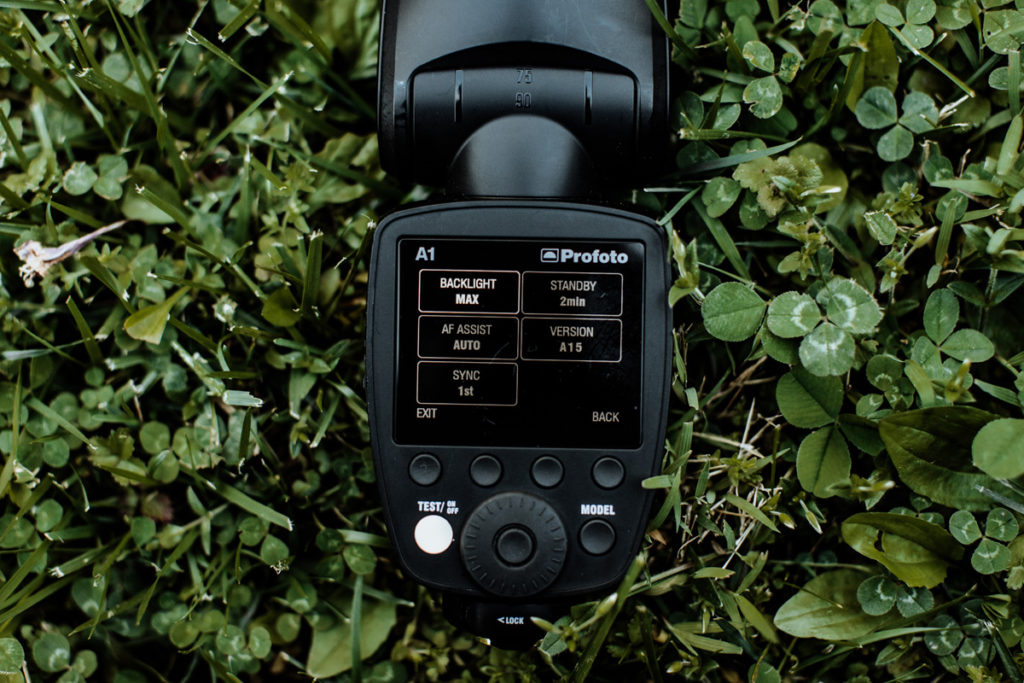
In the second part of the menu, you have access to the following menu items:
- Backlight. You can set the amount of light being outputted by the LCD screen.
- Standby. This can be set to turn off the Profoto A1 after periods of inactivity to conserve battery power. Standby Mode can be set for 2 minutes, 30 minutes, or Never.
- AF Assist. The A1 uses a red laser to help focus in dark environments. AF Assist options include “Off”, “Auto”, and “On”. When working in dark reception halls (for example), we regularly utilize this feature as our cameras can struggle to focus, especially on moving subjects. This works very well in our experience.
- Version. The Profoto A1 you purchase will come with the most recent Firmware. Over time, Profoto releases firmware updates that fix glitches and add additional features. There was actually just a new update released that added more Channel/Group options – a positive change for photographers working with many flashes at once.
- Sync. Lastly, you can control your flash sync modes. The sync modes available are “1st”, “2nd”, “HI-S”, and “X-SYNC”. We regularly use high speed sync (HI-S) so we can increase our shutter speed while using the flash – allowing us to use the flash as a fill while preserving some of the natural ambient light in the environment.
Shooting With the Profoto A1
We use the Profoto A1 in any shooting scenario that requires extra light.
Normally when shooting outdoors, we like to just shoot with the available natural light – but indoors, much of the time our flash comes out and is put to use. We regularly use the A1 at virtually every wedding and event we photograph. At this point, that is 20-25 events plus some smaller shoots that come along.
In this section, we want to showcase some example images we created using the Profoto A1 flash when we photographed the wedding of Nathan Pyle & Taylor Alexy. Nathan Pyle is well known for his New York Time’s Best Selling book NYC Basic Tips and Etiquette and more recently his funny little alien drawings in Strange Planet. In order to photograph an event like this, we needed to be confident in our photography gear’s capabilities to produce the best results. We’d say the A1 fits this bill:
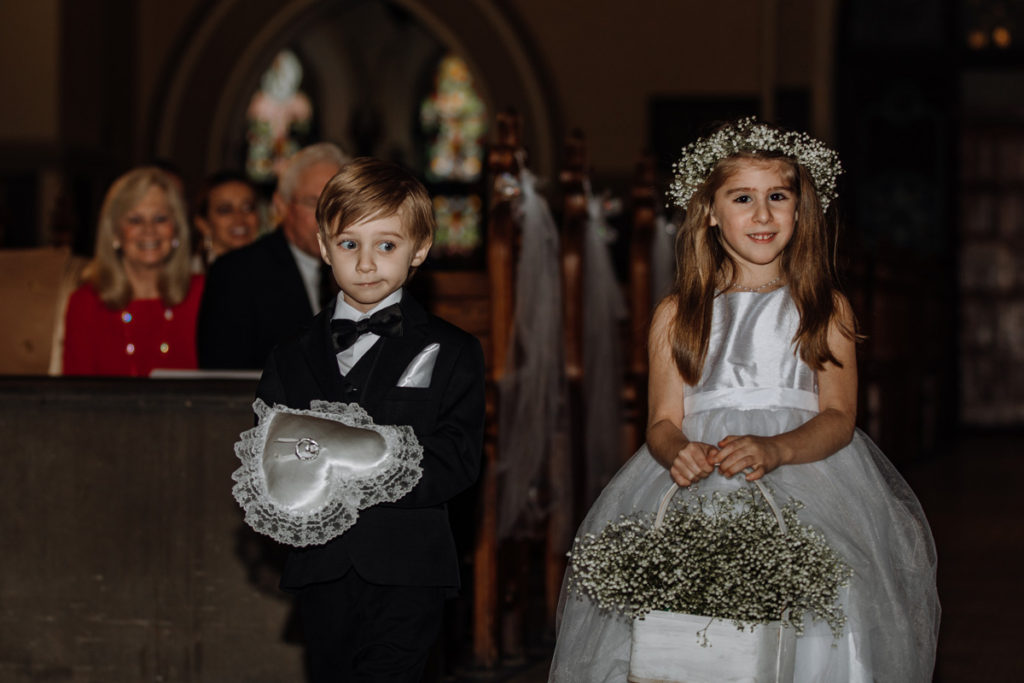
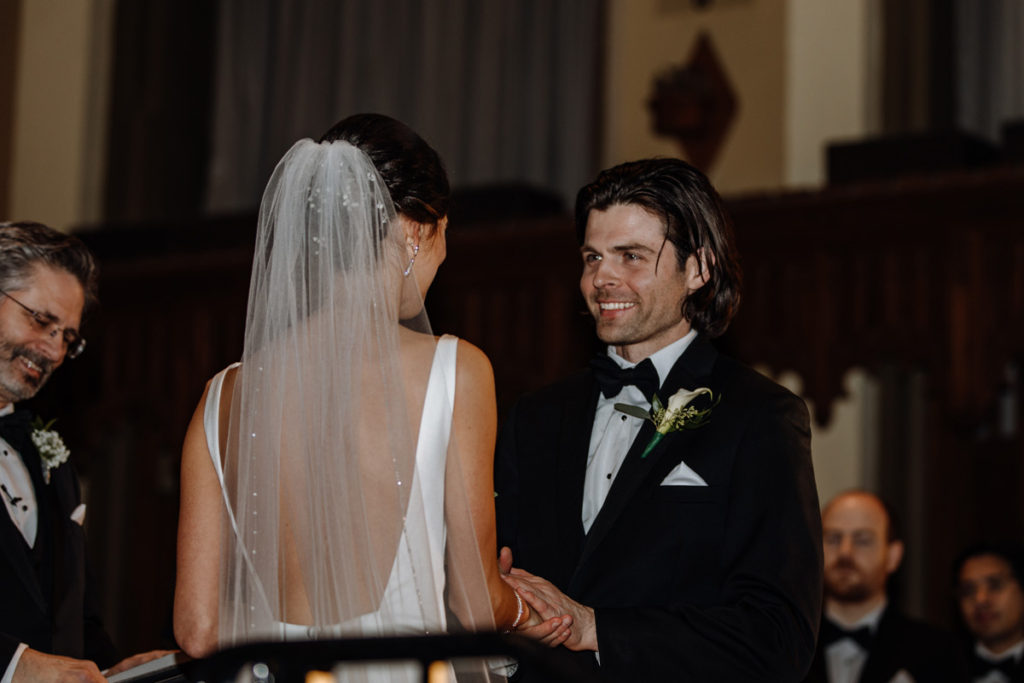
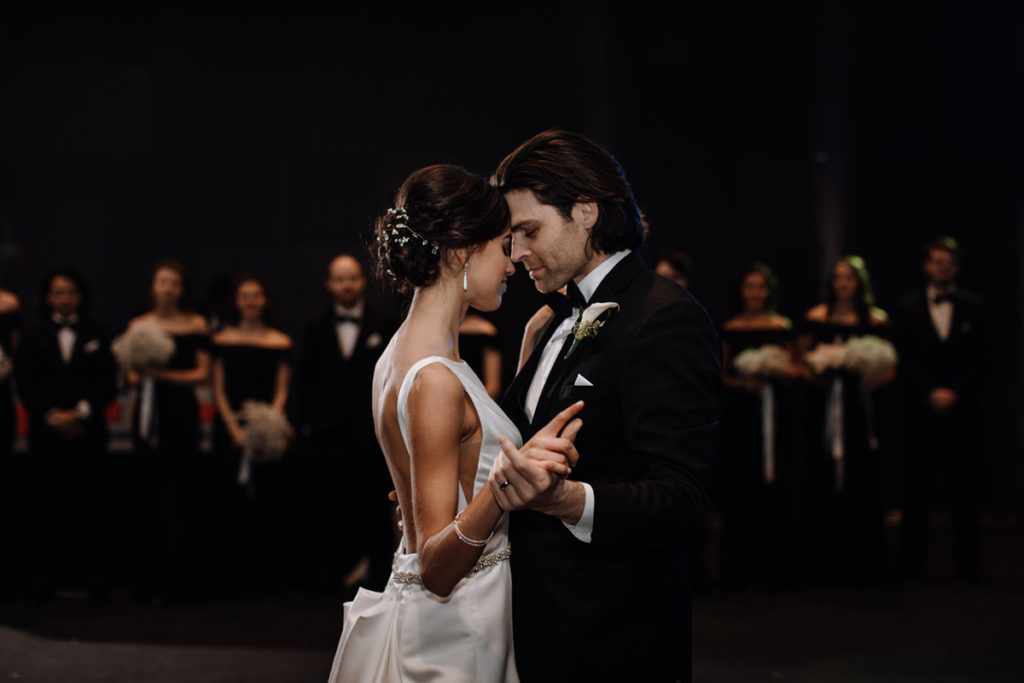
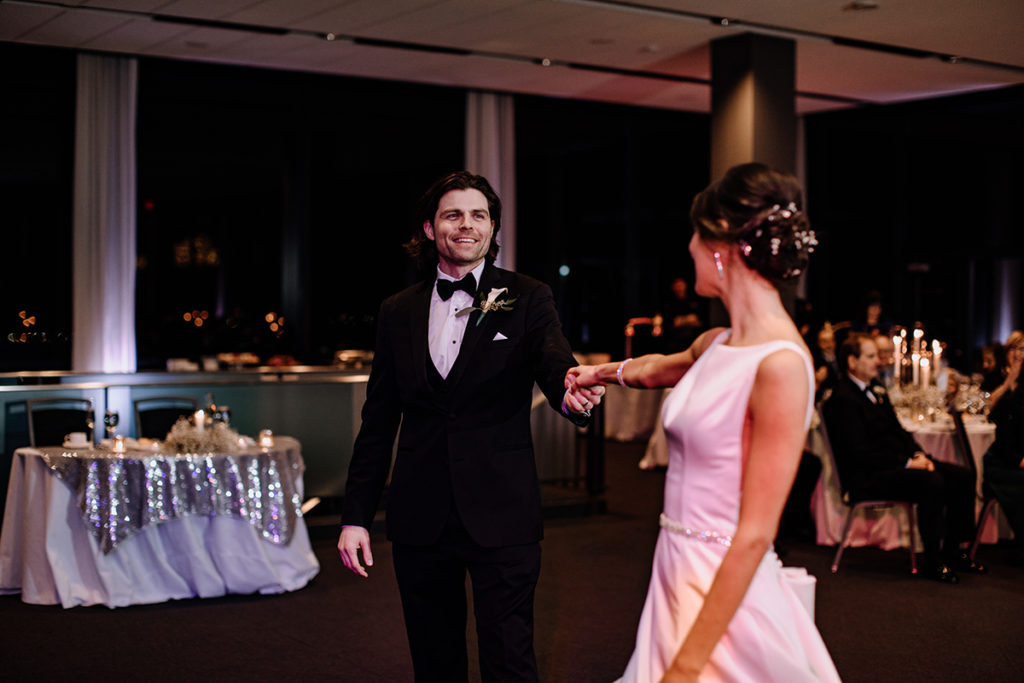

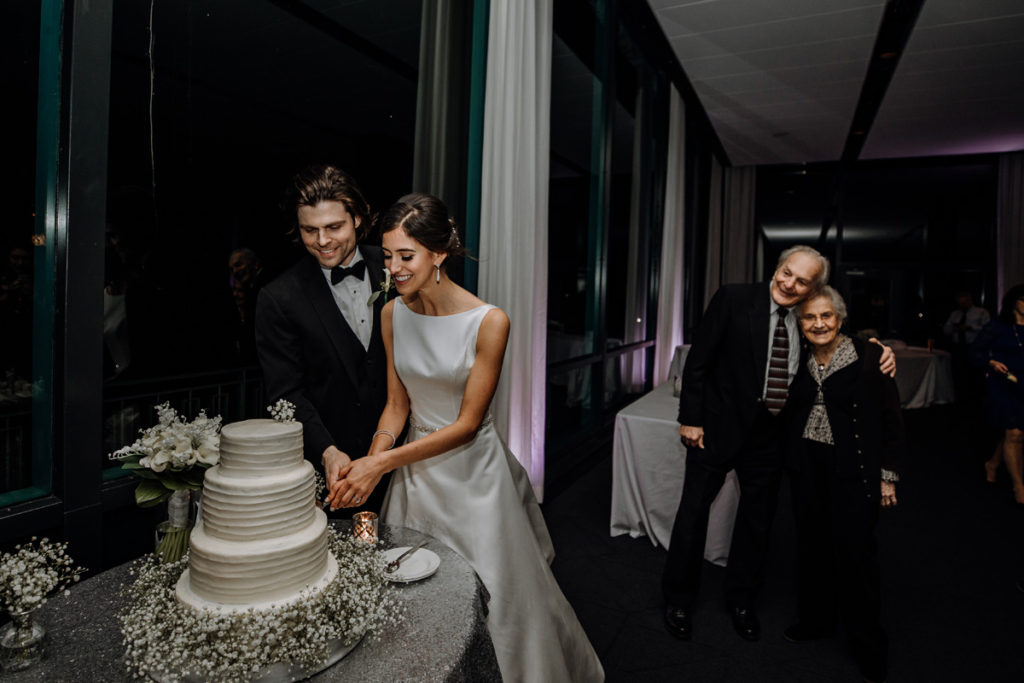

Each of these photos showcases the capabilities of the Profoto A1 to create beautiful looking images. Whether bouncing the flash or pointing it directly at a subject, the light is soft and provides for crisp pictures.
Profoto A1 Challenges & Setbacks
The A1 has been a far more consistent on camera flash than others we have previously used, but that does not mean it doesn’t have it’s downsides.
As we made clear at the start of this post, the price is the first hurdle – but by this point you should have accepted this.
Over our extended period of use, the main problems we have come into are these:
- Batteries die much quicker than expected. Marketing for the A1 suggests that you can shoot an entire wedding (read: 8+ hours) on a single battery. The truth is much different – as we’ve had to buy a handful of additional Profoto A1 batteries to support longer shoot times. These batteries have fortunately dropped in price to some extent, but are still not cheap at around 70$ USD. With this said – the battery performance is still better than needing to swap in 4 AA batteries multiple times throughout a shoot as is the norm with most other speedlights. This is supposed to be something addressed by the just released Profoto A1X flash.
- The A1 doesn’t always sit in the camera hotshoe well. We use Canon 5D Mark IV cameras, and have had issues with the A1 not linking to the camera well. It’s never just fallen off, but there have been instances where there seemed to be a lack of connectivity – causing missed flashes. This has required us to make sure we check and double-check the flash, and take a number of test shots to confirm.
- The Profoto A1 will (sometimes) trigger other Profoto equipment even if the channel/grouping does not match. This is probably the most significant drawback we’ve encountered. As we photograph events as a husband & wife team, both using A1’s as well as a B1X off camera flash, we like to have control of our own equipment. Normally, one of us will link up with the B1X. On quite a few occasions, we have fired the other person’s on camera flash, and have both mapped to the B1X – all while using separate channel setups. Normally hard cycling the unit (turning it off and on again) is enough to fix it – but it’s still frustrating as, in the heat of the moment, it can be confusing what the issue actually is.
The Profoto A1 is Still a Great Flash
Our Profoto A1 review still remains very positive towards this piece of equipment. In our experience, it remains the best on camera flash we have used.
If we lost the A1 in a fire or something, we’d purchase a new one instead of going with a more affordable option just because it provides simple solutions to every day problems we would constantly face.
Other flashes were not just difficult to operate, but felt like we needed to understand some ancient hieroglyphics to work our way through setting them up properly. Ultimately, we’re not “tech” people – we want simple solutions that are easy to use, and we’re 100% willing to pay for that. It makes doing what we want to do (take pictures) easier and less stressful. That alone has been worth the price of admission.
Profoto A1 Review – Conclusion
We highly recommend the Profoto A1 flash.
It has it’s drawbacks, sure, but if you’ve made it to this point in our review – you are very likely thinking this is a flash that would work for you. As we’ve done, we’d suggest checking out the current price on Amazon and picking one up there. Amazon makes this entire process easy, and if you’re not 100% satisfied with how the A1 works for you, you can return it within 30 days for a refund – no questions asked.
The Profoto A1 is available for Canon and Nikon cameras. The newly released Profoto A1X is an upgraded model with some enhancements that is now available for Canon, Nikon, and Sony cameras.